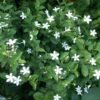Snowflake
Roll over image to zoom in
| Scientific name | Leucojum vernum |
| Common name | Snowflake |
| Watering | water everyday &keep moist |
| Pests | Aphids, Snails, Squirrels |
| Hazardous or not | Not hazardous |
| Light | Full sun |
| Temperature | 25-35C |
| Humidity | 40-50% |
| Pot requirement | Good drainage & repot every 1-2 years |
| Plant height | 50cm |
| Potting mix | potting soil/Red soil/manure/perlite |
| Nutrition | Apply Manure for first 15 days and NPK for next 15 days |
| Pruning/training | Remove dead & diseased leaves with sterile shears |
| Flower colour/season | white |
| Description | Snowflake flourishes in full sun but can also cope with partial shade quite well. Even if planted in the shade with very little access to sunlight, its growth will not be affected too much, though its bloomage may not be quite as full as it otherwise would have been. Though the summer snowflake can be grown in a variety of different soils and will tolerate acidic, alkaline, or neutral pH values, it ideally needs well-draining soil. However, its soil should be able to remain moist without becoming soggy, as this could lead to the bulbs rotting in the ground during dormancy. Chalk, sand, or loam are all excellent choices. Check the soil regularly in the spring and keep it moist. If your summer snowflake is planted in an area that receives full sun, water it in the morning or evening to reduce the amount of moisture that is lost via evaporation. Water more frequently during dry spells, making sure that the soil does not dry out for too long. However, while you should keep the soil moist, be careful that it doesn’t end up waterlogged – this can lead to the bulb rotting in the ground. Though some growers give their summer snowflake an all-purpose fertilizer once it begins to flower, this is not necessary if your soil is rich in nutrients. If you are worried about nutrient content, adding some compost around the plants can help. The summer snowflake is a very low-maintenance plant and will do well with very little input after planting. After blooming has ended for the season, it is vital that you do not cut the foliage back – the leaves create food via photosynthesis to strengthen the bulb for the coming winter and to store energy for the following year’s flowers. Once your summer snowflake has finished blooming, you may wish to cut off the dead flowers for aesthetic purposes, but this isn’t necessary. By mid-summer, the leaves will turn yellow and die as the summer snowflake enters dormancy. Once the leaves are dead, they can be removed. The simplest and most efficient way of propagating summer snowflake is by division. The plant will naturally multiply itself, producing offsets that can be found next to each bulb. In fact, you may wish to just leave the offset in the ground and allow it to grow by itself, next to its mother plant. If you want to plant it elsewhere, carefully dig up the bulb in the fall, detach the offset, and then plant it in the ground as you would a normal bulb. During hot summer spells, a layer of mulch can help to prevent too much water from evaporating, while also keeping the soil temperature cool. |

































Reviews
There are no reviews yet.